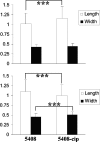Fitness costs and stability of a high-level ciprofloxacin resistance phenotype in Salmonella enterica serotype enteritidis: reduced infectivity associated with decreased expression of Salmonella pathogenicity island 1 genes
- PMID: 19917752
- PMCID: PMC2798541
- DOI: 10.1128/AAC.00801-09
Fitness costs and stability of a high-level ciprofloxacin resistance phenotype in Salmonella enterica serotype enteritidis: reduced infectivity associated with decreased expression of Salmonella pathogenicity island 1 genes
Abstract
The fitness costs associated with high-level fluoroquinolone resistance were examined for phenotypically and genotypically characterized ciprofloxacin-resistant Salmonella enterica serotype Enteritidis mutants (104-cip and 5408-cip; MIC, >32 microg/ml). The stability of the fluoroquinolone resistance phenotype in both mutants was investigated to assess whether clones with better fitness could emerge in the absence of antibiotic selective pressure. Mutants 104-cip and 5408-cip displayed altered morphology on agar and by electron microscopy, reduced growth rates, motility and invasiveness in Caco-2 cells, and increased sensitivity to environmental stresses. Microarray data revealed decreased expression of virulence and motility genes in both mutants. Two clones, 104-revert and 1A-revertC2, with ciprofloxacin MICs of 3 and 2 microg/ml, respectively, were recovered from separate lineages of 104-cip after 20 and 70 passages, respectively, on antibiotic-free agar. All fitness costs, except motility, were reversed in 104-revert. Potential mechanisms associated with reversal of the resistance phenotype were examined. Compared to 104-cip, both 104-revert and 1A-revertC2 showed decreased expression of acrB and soxS but still overexpressed marA. Both acquired additional mutations in SoxR and ParC, and 1A-revertC2 acquired two mutations in MarA. The altered porin and lipopolysaccharide (LPS) profiles observed in 104-cip were reversed. In contrast, 5408-cip showed no reversal in fitness costs and maintained its high-level ciprofloxacin resistance for 200 passages on antibiotic-free agar. In conclusion, high-level ciprofloxacin resistance in S. Enteritidis is associated with fitness costs. In the absence of antibiotic selection pressure, isolates may acquire mutations enabling reversion to an intermediate-level ciprofloxacin resistance phenotype associated with less significant fitness costs.
Figures




Similar articles
-
Multiple regulatory pathways associated with high-level ciprofloxacin and multidrug resistance in Salmonella enterica serovar enteritidis: involvement of RamA and other global regulators.Antimicrob Agents Chemother. 2009 Mar;53(3):1080-7. doi: 10.1128/AAC.01005-08. Epub 2008 Dec 22. Antimicrob Agents Chemother. 2009. PMID: 19104017 Free PMC article.
-
Prevalence of quinolone resistance and mutations in the topoisomerase genes in Salmonella enterica serotype Enteritidis isolates from Serbia.Int J Antimicrob Agents. 2012 Nov;40(5):455-7. doi: 10.1016/j.ijantimicag.2012.07.012. Epub 2012 Sep 20. Int J Antimicrob Agents. 2012. PMID: 22999768
-
Antimicrobial resistance, virulence genes and genetic relatedness of Salmonella enterica serotype Enteritidis isolates recovered from human gastroenteritis in Tehran, Iran.J Glob Antimicrob Resist. 2018 Mar;12:220-226. doi: 10.1016/j.jgar.2017.10.005. Epub 2017 Oct 16. J Glob Antimicrob Resist. 2018. PMID: 29045813
-
Prevalence of gyrA Mutations in Nalidixic Acid-Resistant Strains of Salmonella Enteritidis Isolated from Humans, Food, Chickens, and the Farm Environment in Brazil.Microb Drug Resist. 2017 Jun;23(4):421-428. doi: 10.1089/mdr.2016.0024. Epub 2016 Aug 25. Microb Drug Resist. 2017. PMID: 27559761
-
Quinolone Resistance Determinants of Clinical Salmonella Enteritidis in Thailand.Microb Drug Resist. 2017 Oct;23(7):885-894. doi: 10.1089/mdr.2015.0234. Epub 2017 Feb 23. Microb Drug Resist. 2017. PMID: 28437229
Cited by
-
Genetic mechanisms of antimicrobial resistance identified in Salmonella enterica, Escherichia coli, and Enteroccocus spp. isolated from U.S. food animals.Front Microbiol. 2013 May 23;4:135. doi: 10.3389/fmicb.2013.00135. eCollection 2013. Front Microbiol. 2013. PMID: 23734150 Free PMC article.
-
Non-typhoidal Salmonella infections among children in a tertiary hospital in Ningbo, Zhejiang, China, 2012-2019.PLoS Negl Trop Dis. 2020 Oct 5;14(10):e0008732. doi: 10.1371/journal.pntd.0008732. eCollection 2020 Oct. PLoS Negl Trop Dis. 2020. PMID: 33017418 Free PMC article.
-
Fitness benefits in fluoroquinolone-resistant Salmonella Typhi in the absence of antimicrobial pressure.Elife. 2013 Dec 10;2:e01229. doi: 10.7554/eLife.01229. Elife. 2013. PMID: 24327559 Free PMC article.
-
Antimicrobial resistance and virulence: a successful or deleterious association in the bacterial world?Clin Microbiol Rev. 2013 Apr;26(2):185-230. doi: 10.1128/CMR.00059-12. Clin Microbiol Rev. 2013. PMID: 23554414 Free PMC article. Review.
-
The TCA cycle is not required for selection or survival of multidrug-resistant Salmonella.J Antimicrob Chemother. 2012 Mar;67(3):589-99. doi: 10.1093/jac/dkr515. Epub 2011 Dec 20. J Antimicrob Chemother. 2012. PMID: 22186876 Free PMC article.
References
-
- Alonso, A., G. Morales, R. Escalante, E. Campanario, L. Sastre, and J. L. Martinez. 2004. Overexpression of the multidrug efflux pump SmeDEF impairs Stenotrophomonas maltophilia physiology. J. Antimicrob. Chemother. 53:432-434. - PubMed
-
- Andersson, D. I. 2006. The biological cost of mutational antibiotic resistance: any practical conclusions? Curr. Opin. Microbiol. 9:461-465. - PubMed
-
- Carrique-Mas, J. J., C. Papadopoulou, S. J. Evans, A. Wales, C. J. Teale, and R. H. Davies. 2008. Trends in phage types and antimicrobial resistance of Salmonella enterica serovar Enteritidis isolated from animals in Great Britain from 1990 to 2005. Vet. Rec. 162:541-546. - PubMed
Publication types
MeSH terms
Substances
Grants and funding
LinkOut - more resources
Full Text Sources
Medical
Molecular Biology Databases

